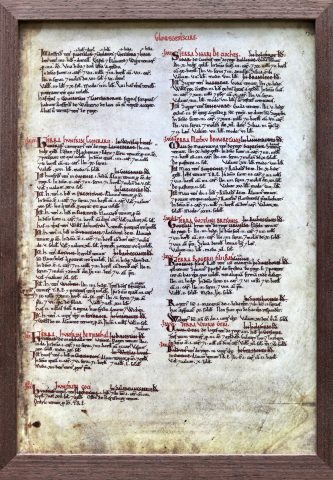Written in Medieval Latin, the Domesday book was a survey of which the main purpose was to determine what taxes had been owed during the reign of King Edward the Confessor, thereby allowing William the Conqueror to reassert the rights of the Crown and assess where power lay after a wholesale redistribution of land following the Norman conquest.

On page 470 of the book can be found the entry concerning Longborough. (See photo above).
The literal translation of Paragraph LXIX reads as follows:
LXIX The land of Humphrey the Chamberlain. In ‘Witley’ Hundred. Humphrey the chamberlain holds of the king – Longborough.
There are 4 hides paying geld. Alston and Blaecmann and Eadricand Alaric held it as 4 manors and could go there whenever they wished. In demesne were 4 ploughs and 3 villans and 5 bordars. There are 9 slaves. It was worth £16 now 100s
Paragraph LXX concerns Sezincote and it reads as follows:
The same Humphrey holds 1 hide in Sezincote. Alwig held it as a manor. In demesne were 2 ploughs and 6 slaves and 1 bordar. It was worth 50s: now only 12d because of the meadows
- Demesne – area of land attached to a manor for ploughing etc. Hides were areas of land paying geld (tax)
- Manor – estate or unit of lordship, varying in size. The Domesday survey was based on the manor and not the parish.
- Villans are unfree peasants who owed his Lord labour of about two or three days a week. Bordars are unfree peasants with less land than a villan
- Plough – an area of land to be ploughed by a team of eight oxen
- Note that the original Longborough is “Lingerberge” and Sezincote is “Cheisnecote”
With special thanks to Mike and Barbara Prior for supplying the photo and the translation.

